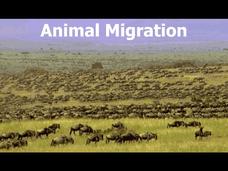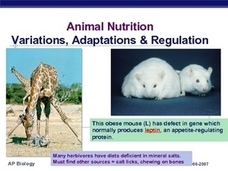Adaptation Teacher Resources
Find Adaptation lesson plans and worksheets
Showing 305 resources
Lesson Planet Curated
Adaptations
Viewers learn about adaptations of plants, animals, and humans through a collection of four Animal League videos. Host Britt Garner discusses behavioral and physical adaptations like camouflage. Also featured are unique adaptions like...
Lesson Planet Curated
The Human Immune System
It's virus-fighting time! The three lessons in the Human Immune system unit module teach young scientists how viruses attack and reproduce and how the immune system protects the body. Pupils first identify unfamiliar terms and tissues...
Lesson Planet Curated
Life Science: Ecosystems and the Flow of Energy
Different ecosystems thrive in various places, with a variety of habitats, including specific plants and animals that have adapted to survive in those specific conditions. But they all have one thing in common: all of the energy that...
Lesson Planet Curated
Unit Two: A Serious Economics Nut
The second unit in the series examines the complex relationships between animals and plants in the whitebark pine community of Waterton-Glacier International Peace Park. In the first of five lessons, scholars mimic Clark’s Nutcracker...
Lesson Planet Curated
Darwin Inspired Learning: Ages 11-14
Inspire young scientists to investigate the natural world, promote an understanding and excitement about how the environment works and how we affect it with four unit modules. Scholars investigate Darwin’s research into bees, consider...
Lesson Planet Curated

Crash Course: Biology
Imagine an entire biology course in one collection of 40 videos! Based on the AP Biology curriculum, viewers learn about the things that make up living things and the processes that keep organisms alive. They also learn how to identify...
Lesson Planet Curated
Activity Book: Discover Your Changing World With NOAA
Introduce middle schoolers to the essential principles of climate science with a collection of 10 activities. Class members learn about the Earth’s climate systems, factors that change these systems, and the impacts of those changes....
Lesson Planet Curated
Learning Ocean Science through Ocean Exploration
The 10 inquiry-based lessons in this collection, developed for NOAA Voyages of Discovery and the Ocean Explorer WebSite, give young oceanographers experience using scientific data and modeling scientific work and thinking. Beginning with...
Lesson Planet Curated
Multimedia Discovery Missions
The Multimedia Discovery Missions collection is a series of 13 interactive presentations and activities that introduce young geologists and oceanographers to fundamental concepts involving the Earth’s crust and ocean sea life. Benthos,...
Curated OER
Human PreHistory 101: Prologue
The Khan Academy displays an animated and narrated clip about human prehistory and the relationships between us and our ancestors. The formal narration is balanced by the hand-drawn animation, making an attraction that is sure to hold...
TED-Ed
The Evolution of the Human Eye
Vision is arguably the most important of the five senses, but exactly how did we come by this amazing ability? Find out with this engaging video on the 500 million year evolution of the human eye.
Curated OER
Adaptations
Cacti have special adaptations for living in desert heat and dryness. Polar bears have adaptations that allow them to withstand icy conditions. Humans adapt to different conditions by wearing appropriate clothing or building homes...
Curated OER
Interdependence and Adaptation
Find out how camels and polar bears are each perfectly suited to their environments because of their physical adaptations. Several key features of each animal are discussed along with how those features work in their specific...
TED-Ed
Can Wildlife Adapt to Climate Change?
Can humans protect other species from the effects of climate change? Can animals adapt or evolve fast enough to survive? Check out this video for some surprising answers.
University of Washington
Animal Migration
Here is a unique resource to use with middle and high schoolers that deals with animal migration. Viewers discover the reasons for, types of, and animals that practice this behavioral adaptation. Specific animals that are introduced...
Howard Hughes Medical Institute
Recent Adaptations in Humans
You've probably spent plenty of time discussing animal adaptations with your young biologists, but what about human adaptations? Explore the evolving traits of humankind through an interactive that combines text and video clips. Scholars...
Curated OER
Animal Nutrition - Variations, Adaptations, & Regulation
Colorful pictures and graphics make this a visually-appealing presentation on animal nutrition. Be aware that two of the sixteen slides include blank graphic organizers, so you will need to find the other existing version of this...
TED-Ed
How Whales Breathe, Communicate... and Fart with Their Faces
Dr. Joy Reidenberg is an expert in comparative anatomy, but also quite relatable to preteens! Here, she lectures on echolocation by likening it to "farting with the face!" She explains with film, actual whale voice recordings, diagrams,...
TED-Ed
Poison vs. Venom: What's the Difference?
Did you know that poison and venom are not the same? Both are toxic, but poison must be inhaled, ingested, or absorbed, while venom must be injected into a wound. The narrator explains that some toxic compounds may be used for good, as...
TED-Ed
Climate Change: Earth's Giant Game of Tetris
In this colorful animation, our current problem with climate change is likened to a block-stacking game of Tetris. Greenhouse gases are increasing in the atmosphere at an increasing rate. Can we place them properly before it's too late?...
PBS
When Humans Were Prey
A quarry worker in southern Africa discovered the first fossil evidence that the human species originated on the continent less than 100 years ago! Evidence from the specimen indicates the first humans were not the hunters—but the prey....
Aquarium of the Pacific
Amazing Adaptations
We can all adapt. Classmates watch a video about the adaptations of sea horses that allow them to eat and move. They then watch penguins on webcams to see what adaptations help the penguins find food, move, and avoid predators. Finally,...
TED-Ed
How Do Viruses Jump from Animals to Humans?
Can humans be infected by animal viruses? Pupils explore the phenomenon of viral evolution and learn about how animal viruses sometimes adapt to infect humans. They see how viruses are transmitted and what pathogens need to survive. The...
TED-Ed
What Would Happen If Every Human Suddenly Disappeared?
Humans constantly change the earth by building things, using natural resources, and relocating plants and animals. The lesson considers would happen to the planet if humans were gone. The narrator discusses the changes in buildings and...

























